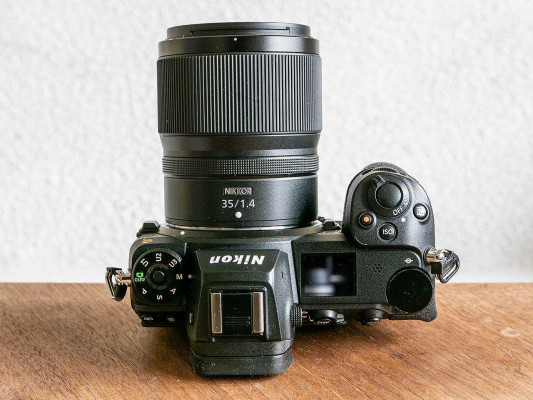Reviews

Wildlife Photographer of the Year winners showcase wonders of our natural world
DPReview LatestWildlife Photographer of the Year winners
 |
The Natural History Museum has announced the winners of its prestigious Wildlife Photographer of the Year competition. This year, the museum received a record-breaking 59,228 entries from 117 countries and territories and granted awards to 100 photos. The two Grand Title winners were selected from 18 category winners.
Celebrating its 60th year, Wildlife Photographer of the Year is developed and produced by the Natural History Museum, London. You can visit the exhibition in person at the museum beginning Friday, October 11, and on tour around the UK and in Australia, Canada, Denmark, France, Germany, Italy and Switzerland, with more locations to be announced. The exhibition features all 100 winning images, videos showing the impact wildlife photography can have globally, and past Grand Title winners.
Here, we present some of our favorites, including the Grand Title and winners of many award categories.
Wildlife Photographer of the Year: Grand Title
 |
The Swarm of Life by Shane Gross, Canada
Wildlife Photographer of the Year: Grand Title
Winner, Wetlands: The Bigger Picture
Shane Gross looks under the surface layer of lily pads as a mass of western toad tadpoles swim past. Shane snorkeled in the lake for several hours through carpets of lily pads. This prevented any disturbance of the fine layers of silt and algae covering the lake bottom, which would have reduced visibility. Western toad tadpoles swim up from the safer depths of the lake, dodging predators and trying to reach the shallows, where they can feed. The tadpoles start becoming toads between four and 12 weeks after hatching. An estimated 99% will not survive to adulthood.
Location: Cedar Lake, Vancouver Island, British Columbia, Canada
Technical details: Nikon D500 + Tokina fisheye 10–17mm F3.5–4.5 lens at 11mm; 1/200 at F13; ISO 640; 2x Sea & Sea strobes; Aquatica housing
Copyright Shane Gross / Wildlife Photographer of the Year
Young Wildlife Photographer of the Year: Grand Title
 |
Life Under Dead Wood by Alexis Tinker-Tsavalas, Germany
Young Wildlife Photographer of the Year: Grand Title
Winner, 15-17 Years
Alexis Tinker-Tsavalas rolls a log over to see the fruiting bodies of slime mold and a tiny springtail. Alexis worked fast to take this photograph, as springtails can jump many times their body length in a split second. He used a technique called focus stacking, where 36 images, each with a different area in focus, are combined. Springtails are barely two millimeters long (less than a tenth of an inch). They are found alongside slime molds and leaf litter all over the world. They feed on microorganisms such as bacteria and fungi, improving soil by helping organic matter to decompose.
Location: Berlin, Germany
Technical details: Panasonic Lumix G91 + Laowa 25mm F2.8; 2.5–5x ultra macro lens; 1/200 at F4; ISO 200; Nikon SB-900 Speedlight flash; Cygnustech macro diffuser; focus stack of 36 images
Copyright Alexis Tinker-Tsavalas / Wildlife Photographer of the Year
Winner: Urban Wildlife
 |
Tiger in Town by Robin Darius Conz, Germany
Winner, Urban Wildlife
Robin Darius Conz watches a tiger on a hillside against the backdrop of a town where forests once grew. Robin was following this tiger as part of a documentary team filming the wildlife of the Western Ghats. On this day, he used a drone to watch the tiger explore its territory before it settled in this spot. The protected areas in the Western Ghats, where tigers are carefully monitored, are some of the most biodiverse landscapes in India and have a stable population of tigers. Outside these areas, where development has created conflict between humans and wildlife, tiger occupancy has declined.
Location: Nilgiris, Tamil Nadu, India
Technical details: DJI Mavic 3 Pro Cine + 70mm F2.8 lens; 1/15 at F2.8; ISO 400
Copyright Robin Darius Conz / Wildlife Photographer of the Year
Winner, Behavior: Birds
 |
Practice Makes Perfect by Jack Zhi, USA
Winner, Behavior: Birds
Jack Zhi enjoys watching a young falcon practicing its hunting skills on a butterfly above its sea-cliff nest. Jack has been visiting this area for the past eight years, observing the constant presence of one of the birds and photographing the chicks. On this day, it was a challenge to track the action because the birds were so fast. Should this young peregrine falcon make it to adulthood, tests have shown it will be capable of stooping or dropping down on its prey from above at speeds of more than 300 kilometers per hour (186 miles per hour).
Location: Los Angeles, California, USA
Technical details: Sony α9 II + 600mm F4 lens; 1/4000 at F5.6; ISO 640
Copyright Jack Zhi / Wildlife Photographer of the Year
Winner, Oceans: The Bigger Picture
 |
A Diet of Deadly Plastic by Justin Gilligan, Australia
Winner, Oceans: The Bigger Picture
Justin Gilligan (Australia) creates a mosaic from the 403 pieces of plastic found inside the digestive tract of a dead flesh-footed shearwater. Justin has been documenting Adrift Lab’s work for several years, often joining them on beach walks at dawn to collect dead chicks. The team brings together biologists from around the world to study the impact of plastic pollution on marine ecosystems. Studies found that three-quarters of adult flesh-footed shearwaters breeding on Lord Howe Island – and 100% of fledglings – contained plastic. The team, including a Natural History Museum scientist, discovered it causes scarring to the lining of the digestive tract, a condition called plasticosis.
Location: Lord Howe Island, New South Wales, Australia
Technical details: Nikon D850 + 24–70mm F2.8 lens; 1/125 at F11; ISO 400; Profoto B10 + A1 flash
Copyright Justin Gilligan / Wildlife Photographer of the Year
Winner, Behavior: Invertebrates
 |
The Demolition Squad by Ingo Arndt, Germany
Winner, Behavior: Invertebrates
Ingo Arndt documents the efficient dismemberment of a blue ground beetle by red wood ants. ‘Full of ant’ is how Ingo described himself after lying next to the ants’ nest for just a few minutes. Ingo watched as the red wood ants carved an already dead beetle into pieces small enough to fit through the entrance to their nest. Much of the red wood ants’ nourishment comes from honeydew secreted by aphids, but they also need protein. They are capable of killing insects and other invertebrates much larger than themselves through sheer strength in numbers.
Location: Hessen, Germany
Technical details: Canon EOS 5DS R + 100mm F2.8 lens; 1/200 at F8; ISO 400; Canon Macro Twin Lite MT-24EX flash; softboxes
Copyright Ingo Arndt / Wildlife Photographer of the Year
Winner, Photojournalism
 |
Dusting for New Evidence by Britta Jaschinski, Germany/UK
Winner, Photojournalism
Britta Jaschinski looks on as a crime scene investigator from London’s Metropolitan Police dusts for prints on a confiscated tusk. Britta spent time at the CITES Border Force department, where confiscated animal products are tested. Newly developed magnetic powder allows experts to obtain fingerprints from ivory up to 28 days after it was touched, increasing the chances of identifying those involved in its illegal trade. The International Fund for Animal Welfare has distributed more than 200 specially created kits to border forces from 40 countries. They have been instrumental in four cases that resulted in 15 arrests.
Location: Heathrow Airport, London, England, UK
Technical details: Leica SL2 + 24–90mm F2.8–4 lens at 62mm; 1/80 at F3.8; ISO 200
Copyright Britta Jaschinski / Wildlife Photographer of the Year
Winner, 11-14 Years
 |
An Evening Meal by Parham Pourahmad, USA
Winner, 11-14 Years
Parham Pourahmad watches as the last rays of the setting sun illuminate a young Cooper’s hawk eating a squirrel. Over a single summer, Parham visited Ed R Levin County Park most weekends to take photographs. He wanted to showcase the variety of wildlife living within a busy metropolitan city and to illustrate that ‘nature will always be wild and unpredictable’. The Cooper’s hawk is a common species across southern Canada, the USA, and central Mexico, where it inhabits mature and open woodlands. These adaptable birds also live in urban spaces, where there are tall trees to nest in and bird feeders that attract smaller birds, which they can prey on.
Location: Ed R Levin County Park, California, USA
Technical details: Nikon D3500 + Sigma 150–600mm F5-6.3 lens at 210mm; 1/400 at F6.3; ISO 800
Copyright Parham Pourahmad / Wildlife Photographer of the Year
Winner, Animals in their Environment
 |
Frontier of the Lynx by Igor Metelskiy, Russia
Winner, Animals in their Environment
Igor Metelskiy shows a lynx stretching in the early evening sunshine, its body mirroring the undulating wilderness. The remote location and changing weather conditions made access to this spot – and transporting equipment there – a challenge. Igor positioned his camera trap near the footprints of potential prey. It took more than six months of waiting to achieve this relaxed image of the elusive lynx. A survey carried out in 2013 estimated the entire Russian lynx population was around 22,500 individuals, with numbers for the Russian Far East, including those in Primorsky Krai, at 5,890.
Location: Lazovsky District, Primorsky Krai, Russia
Technical details: Sony α7 IV + 24–70mm F2.8 lens; 1/500 at F5.6; ISO 100; Scout camera controller + PIR motion sensor
Copyright Igor Metelskiy / Wildlife Photographer of the Year
Winner, Impact Award
 |
Recording by Hand by Liwia Pawłowska, Poland
Winner, Impact Award
Liwia Pawłowska watches as a relaxed common whitethroat is gently held by a bird ringer. Liwia is fascinated by bird ringing and has been photographing ringing sessions since she was nine. She says that she hopes her photograph ‘helps others to get to know this topic better.’ Volunteers can assist trained staff at bird-ringing sessions, where a bird’s length, sex, condition and age are recorded. Data collected helps scientists to monitor populations and track migratory patterns, aiding conservation efforts.
Location: Rgielsko, Greater Poland Voivodeship, Poland
Technical details: Nikon Coolpix P900; 1/400 at F5; ISO 100
Copyright Liwia Pawlowska / Wildlife Photographer of the Year
Winner, Impact Award
 |
Hope for the Ninu by Jannico Kelk, Australia
Winner, Impact Award
Jannico Kelk illuminates a ninu, with the wire grass and shrubs behind it providing a frame against the darkness. Jannico spent each morning walking the sand dunes of a conservation reserve, searching for footprints that this rabbit-sized marsupial may have left the night before. Finding tracks near a burrow, he set up his camera trap. The greater bilby has many Aboriginal names, including ninu. It was brought to near extinction through predation by introduced foxes and cats. Within fenced reserves where many predators have been eradicated, the bilby is thriving.
Location: Arid Recovery, Roxby Downs, South Australia, Australia
Technical details: Canon EOS 60D + 24mm F2.8 lens; 1/80 at F9; ISO 320; 3x Nikon SB-28 Speedlight flashes; Camtraptions PIR motion sensor
Copyright Jannico Kelk / Wildlife Photographer of the Year
Winner, Behavior: Amphibians and Reptiles
 |
Wetland Wrestle by Karine Aigner, USA
Winner, Behavior: Amphibians and Reptiles
Karine Aigner recognizes the skin of a yellow anaconda as it coils itself around the snout of a yacaré caiman. The tour group Karine was leading had stopped to photograph some marsh deer when she noticed an odd shape floating in the water. Through binoculars, Karine quickly recognized the reptiles and watched as they struggled with each other. Caimans are generalist feeders and will eat snakes. As anacondas get larger, they will include reptiles in their diet. It’s hard to determine who is the aggressor here. On the snake’s back are two tabanids, blood-sucking horseflies that are known to target reptiles.
Location: Transpantaneira Highway, Mato Grosso, Brazil
Technical details: Sony α1 + 200–600mm F5.6–6.3 lens; 1/400 at F16; ISO 800
Copyright Karine Aigner / Wildlife Photographer of the Year
Winner, Animal Portraits
 |
On Watch by John E Marriott, Canada
Winner, Animal Portraits
John E Marriott frames a lynx resting, with its fully grown young sheltering from the cold wind behind it. John had been tracking this family group for almost a week, wearing snowshoes and carrying light camera gear to make his way through snowy forests. When fresh tracks led him to the group, he kept his distance to make sure he didn’t disturb them. Lynx numbers usually reflect the natural population fluctuations of their main prey species, the snowshoe hare. With climate change reducing snow coverage, giving other predators more opportunities to hunt the hares, hare populations may decline, in turn affecting the lynx population.
Location: Yukon, Canada
Technical details: Canon EOS 5D Mark IV + 100–400mm fF.5–5.6 lens at 400mm; 1/800 at F9; ISO 1250
Copyright John E Marriott / Wildlife Photographer of the Year
Winner, Photojournalist Story Award
 |
Dolphins of the Forest by Thomas Peschak, Germany/South Africa
Winner, Photojournalist Story Award
‘Among the Trees’: The Amazon river dolphin is one of two freshwater dolphin species living in the Amazon and Orinoco basins. Only this species has evolved to explore the seasonally flooded forest habitat.
Portfolio Story: Thomas Peschak documents the relationship between endangered Amazon river dolphins, also known as botos or pink river dolphins, and the people with whom they share their watery home. The Amazon river dolphin’s relationship with humans is complex. Traditional Amazonian beliefs hold that the dolphins can take on human form, and they are both revered and feared. Others see them as thieves who steal fish from nets and should be killed. Thomas took these images in areas where local communities are creating opportunities for tourists to encounter the dolphins. This brings another set of problems: when they’re fed by humans, the dolphins become unhealthy, and younger individuals don’t learn to hunt for themselves.
Technical details: Nikon Z9 + 14–30mm F4 lens at 16mm; 1/320 at F6.3; ISO 1250
Location: Brazil and Colombia
Copyright Thomas Peschak/ Wildlife Photographer of the Year
Winner, Rising Star Portfolio Award
 |
The Serengeti of the Sea by Sage Ono, USA
Winner, Rising Star Portfolio Award
‘Rubies and Gold’: These tube-snout fish eggs will fade in color as the embryos develop. But for now, they sparkle like gems next to the kelp’s gold, glowing, gas-filled buoyancy aids. The green serrated edges of the kelp fronds complete the simple composition.
Portfolio Story: Sage Ono explores the abundant life around the giant kelp forests in Monterey Bay National Marine Sanctuary. Inspired by the stories told by his grandfather, a retired marine biologist, and by a photograph of a larval cusk eel, Sage acquired a compact underwater camera and decided to take up underwater photography. After university, he moved to the coast near the Monterey Bay National Marine Sanctuary to pursue his interest. Here, it’s the submerged world of the bay’s forests of giant kelp – the biggest of all seaweeds – and the diversity of life they contain that have captured his imagination.
Technical details: Nikon D850 + 60mm F2.8 lens; 1/160 at F14; ISO 250; Nauticam NA-D850 housing; 2x Sea & Sea YS-D2J strobes
Location: California, USA
Copyright Sage Ono / Wildlife Photographer of the Year






















